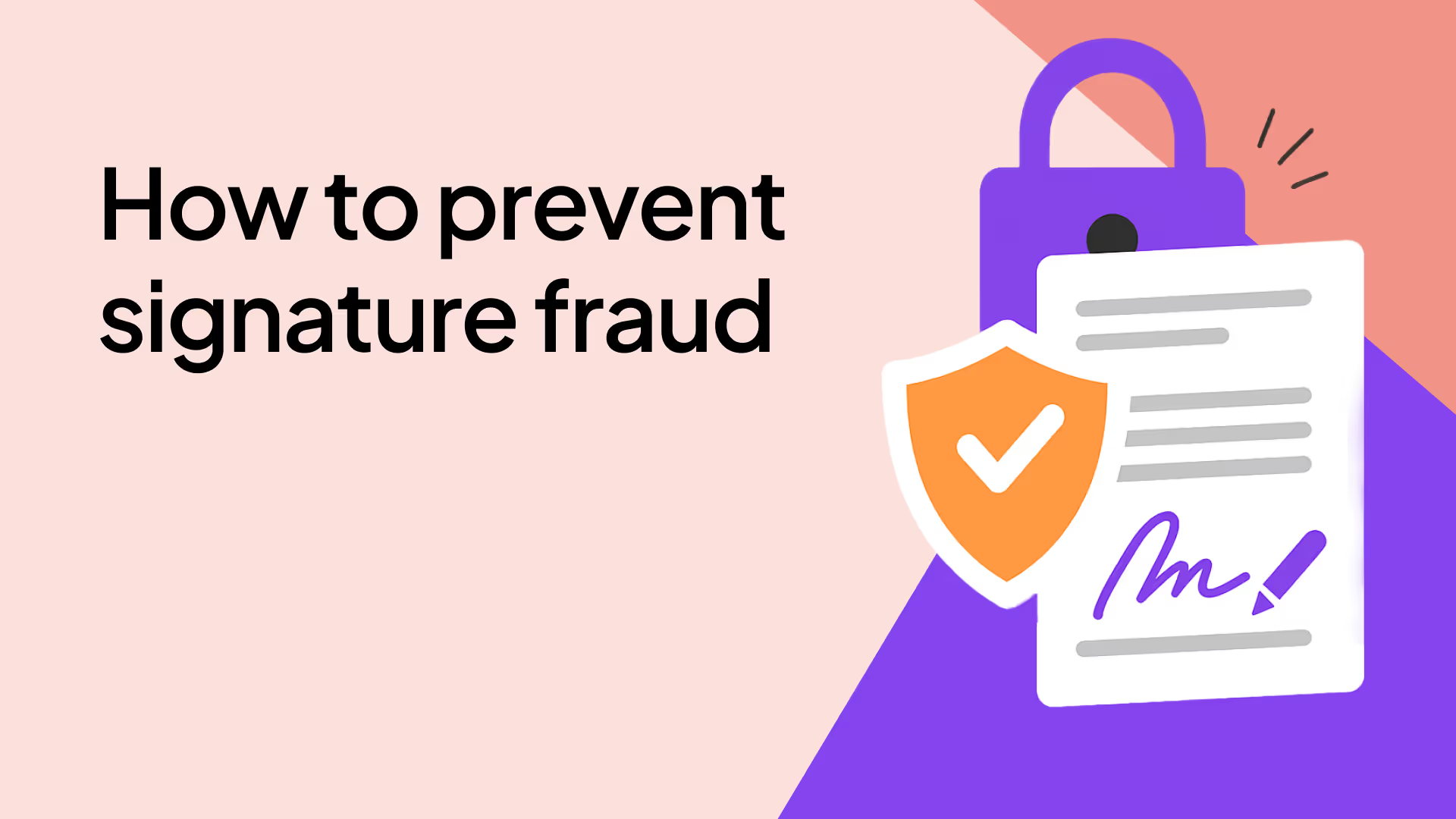When it comes to digital paperwork, businesses MUST pay attention to two critical security aspects:
- Preventing Signature Fraud
- Ensuring Maximum Enforceability of Digital Documents
Businesses that neglect this are at serious risk of their paperless dreams crumbling because:
- Digital processes come under regulatory scrutiny
- Businesses discard digital processes – and revert back to physical
- Customers lose trust in the entire process
With Leegality’s Document Infrastructure, we’ve built a comprehensive set of tools that make your digital documents fraud-proof AND easier to enforce. You can pick and choose which tools you want - depending on the requirements of your legal teams or your use case in question.
Let’s dive in.
Aadhaar/DSC Smart Name Verification
We’ve written about this feature in detail before (link to the blog). If you want a deep dive into the WHY, HOW and WHAT of the feature please click on that link.
Why we built Aadhaar/DSC Smart Name Verification
In remote document journeys - where the customer is digitally signing from the comfort of their home without your agent or field officer present - there is a serious risk of customers using someone else’s Aadhaar or DSC token.
This can cause compliance and enforcement issues later on - where the signature won’t match the identity of the party you are dealing with.
How Aadhaar/DSC Smart Name Verification helps you prevent this
With Aadhaar/DSC Smart Name Verification you can set “match parameters” with information you collect from the signer prior to the document execution like name, PIN Code, Gender, Address or masked Aadhaar number (last 4 digits of Aadhaar).
When the signer eSigns via Aadhaar/DSC - Leegality matches the signature certificate details (which also contains these parameters) with the “match parameters” that you have set for that signer.
If they match, then it means the signer has used their own Aadhaar/DSC to eSign.
If there is a mismatch, it means the signer has used someone else’s Aadhaar/DSC to eSign. Leegality will automatically cancel the document journey to prevent the wrong signature from being applied.
You can also check the eSign verification results and identify which parameter caused the verification to fail or pass.

What’s Smart about it?
In India, even if the signer is using their Aadhaar/DSC - sometimes there will be parameters that naturally mismatch. Their name on Aadhaar might differ slightly from the name they give you during onboarding. This isn’t fraud - it’s just natural.
With Smart Name Verification, you can set a % match to ensure minor discrepancies don’t break the journey.
Face Capture with Liveliness Check
Why we built Face Capture
There are two distinct problems that led to this feature being developed:
- In both remote and assisted document journeys, someone else may try to sign on behalf of the signer. In such scenarios, you could be exposed to liability and regulatory scrutiny unless you have proper processes to prevent this.
- In some cases, signers may treat documents and contractual terms frivolously
How Face Capture helps solve this problem
With Face Capture activated, Leegality will capture a photo of the signer before they can move onto the signing step. Leegality does this by capturing a 15 second video of the signer - and then generating 3 photos of the signer based on this video.
The 3 photos are then recorded in the Secure Audit Trail - ensuring you have verifiable evidence that the signer was present while eSigning the document. Signers also tend to take the entire process more seriously when they are made to undergo a face capture.
The Leegality Face Capture Cam can detect whether a person’s face is in front of the camera or not. With User Liveliness enabled, you can also safeguard against signers spoofing the signing journey by showing a photo instead of their live face.
This entire flow happens smoothly within the same journey - minimizing risk of signer drop offs.
Here’s a short demo video showcasing Face Capture:
Geo-Location Capture
Why we built Geo-Location Capture
Many companies choose to implement digital paperwork in their assisted branch journeys - where the field/branch officer is present with the signer at the time of execution. In such flows it is critical to ensure that the signing is happening AT THE BRANCH ITSELF - to ensure that there is no fraud by the field officer at the ground level.
How Geo-Location Capture helps
With Geo-Location capture, the GPS coordinates of the device on which the document is being executed are captured before the signing step. These coordinates are then stored on the Secure Audit Trail.
This ensures that there is verifiable evidence of the place of execution. Signers cannot later deny that they weren’t present at the branch or that the field/branch officer performed eSign on their behalf at some other location.
Here's a short video of how Geo-Location Capture works:
Multi-Factor Authentication for Document Access
Why we built Multi-Factor Authentication
Document journeys via Leegality all involve an OTP step - either via email or SMS - at some point. This ensures that the signer is wilfuly performing the act of eSigning.
But what about the possibility that someone else has access to the email inbox or mobile device of the signer? For many documents, legal/compliance teams will require that the digital execution journey safeguard against this.
How Multi-Factor Authentication helps
With Muli-Factor Authentication, you can mandate that the signer authenticate themselves via an OTP sent to both email AND SMS. The Secure Audit Trail records both authentications to ensure you have verifiable evidence that Multi-Factor Authentication was performed.
So even if the signer leaves their email inbox open in office - their colleague cannot perform an unauthorized signature since they won’t have access to their SMS.

Template Auto-Populate and Lock
Why we built Template Auto Populate
Physical paperwork journeys across industries are plagued by the spectre of “blank form signing” i.e where the agent/field officer makes the customer sign on blank forms - and later fills in wrong details that the customer never consented to.
Even in cases where there is no fraud, agents can often make mistakes while populating documents - leading to serious legal risk down the road.
With digital paperwork, companies have a golden opportunity to make blank form signing AND mistaken entries impossible.
How Template Auto-Populate Helps
With Template Auto-Populate, you can automatically populate your templates with data directly from your data repositories like an LOS/LMS system or an ERP. The discretion of “filling in the template” is taken out of the hands of your field officers/agents - thereby eliminating blank form signing and eliminating manual errors.
Secure Audit Trails
Why Secure Audit Trails exist
There’s no use having all the above modes of enhancing ease of enforcement without an easy and verifiable way to produce them as evidence in Court. That’s where Secure Audit Trails come in.
What’s the big deal about Secure Audit Trails
Standard order audit trails issued by “eSign tools” are plagued with serious vulnerabilities. They are usually an operational formality - giving you a skinny document with basic details about the signing journey.
Leegality isn’t a eSign tool - we are a Document Infrastructure Platform that enables businesses in India to digitally transform ALL paperwork processes end-to-end.
So unlike standard order audit trails, which are designed to tick a checkbox, our Secure Audit Trails are built for your legal and compliance teams. They give you an unprecedented level of enforceability for documents.
Here’s how:
- Capturing All Details - Secure Audit Trails capture each and every step of the execution journey like:
- Stamp paper ID
- Time-stamp of signing events
- Consent language captured
- Signer email ID and/or phone number
- Type of eSign used
- eSign Certificate Details
- Geo-location and Face Capture
- Multi-Factor Authentication Record
- eSign Verification Record
By capturing all these details, we ensure that the execution of the document is seen to be true beyond any reasonable doubt.
- Secure Electronic Records under Evidence Act - Secure Audit Trails meet the requirements of being a “secure electronic record” under the IT Act. This means that they have evidentiary presumptions of validity under S. 85B of the Evidence Act - making them radically easier to enforce than other transactional logs.
%2525201.avif)
“The platform provided to Arohan by Leegality captures live images, geo-coordinates, phone details, and IP addresses of the customers when they e-sign a document. All these pieces of information are available and stored in the audit trail. This makes the work simpler for the compliance team.” - Arvind Murarka, Senior Vice President and Head - IT @Arohan Financial Services
With Leegality’s Document Enforceability Tools you can make digital paperwork journeys secure in a way that would have been impossible with your physical processes.
Want to take the step towards actually secure paperwork? Reach out to us on enquiry@leegality.com- we’ll customize a demo of these features tailored to your use case AND give you a free sandbox account so that you can try them for yourself.

















